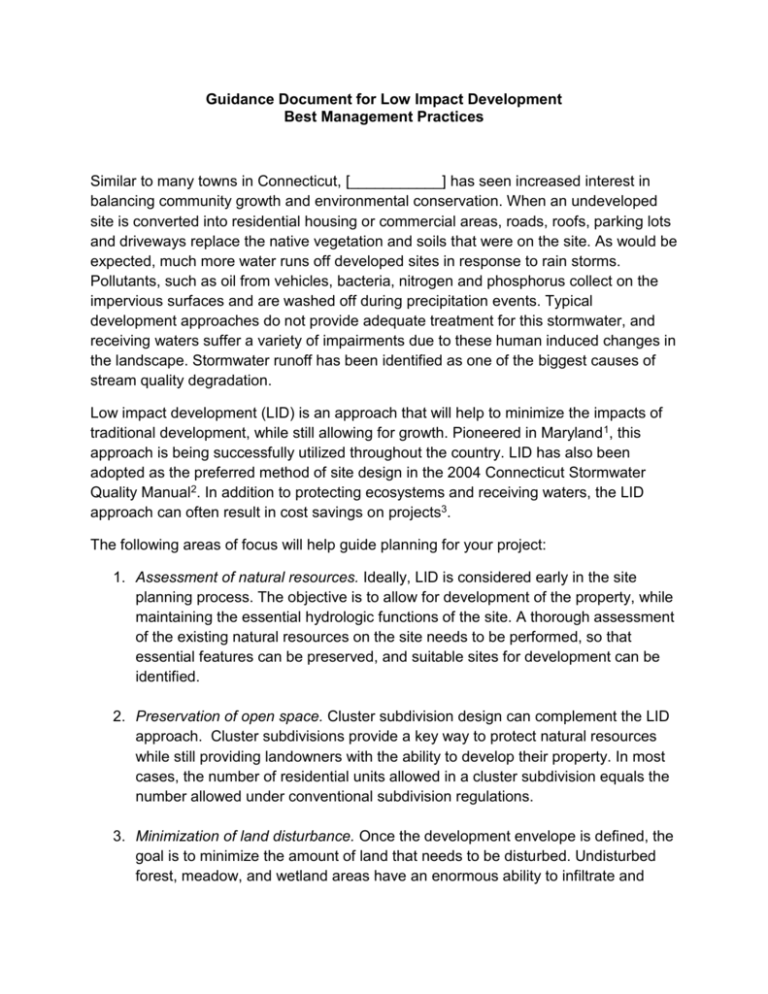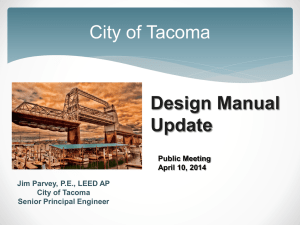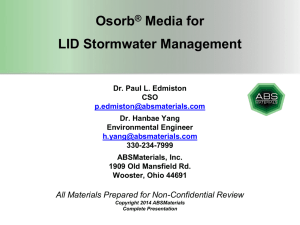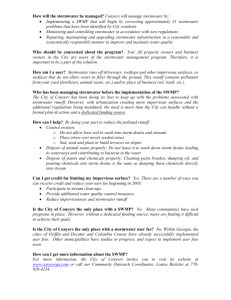CT NEMO`s sample LID Checklist
advertisement

Guidance Document for Low Impact Development Best Management Practices Similar to many towns in Connecticut, [___________] has seen increased interest in balancing community growth and environmental conservation. When an undeveloped site is converted into residential housing or commercial areas, roads, roofs, parking lots and driveways replace the native vegetation and soils that were on the site. As would be expected, much more water runs off developed sites in response to rain storms. Pollutants, such as oil from vehicles, bacteria, nitrogen and phosphorus collect on the impervious surfaces and are washed off during precipitation events. Typical development approaches do not provide adequate treatment for this stormwater, and receiving waters suffer a variety of impairments due to these human induced changes in the landscape. Stormwater runoff has been identified as one of the biggest causes of stream quality degradation. Low impact development (LID) is an approach that will help to minimize the impacts of traditional development, while still allowing for growth. Pioneered in Maryland 1, this approach is being successfully utilized throughout the country. LID has also been adopted as the preferred method of site design in the 2004 Connecticut Stormwater Quality Manual2. In addition to protecting ecosystems and receiving waters, the LID approach can often result in cost savings on projects3. The following areas of focus will help guide planning for your project: 1. Assessment of natural resources. Ideally, LID is considered early in the site planning process. The objective is to allow for development of the property, while maintaining the essential hydrologic functions of the site. A thorough assessment of the existing natural resources on the site needs to be performed, so that essential features can be preserved, and suitable sites for development can be identified. 2. Preservation of open space. Cluster subdivision design can complement the LID approach. Cluster subdivisions provide a key way to protect natural resources while still providing landowners with the ability to develop their property. In most cases, the number of residential units allowed in a cluster subdivision equals the number allowed under conventional subdivision regulations. 3. Minimization of land disturbance. Once the development envelope is defined, the goal is to minimize the amount of land that needs to be disturbed. Undisturbed forest, meadow, and wetland areas have an enormous ability to infiltrate and process rainfall, providing baseflow to local streams and groundwater recharge. Construction equipment causes severe compaction of soils, so after development, even areas that are thought to be pervious such as grass, can be quite impervious to rainfall. 4. Reduce and disconnect impervious cover. With careful planning, the overall percentage of impervious cover in a proposed project can be minimized. Roads, driveways, sidewalks, parking lots, and building footprints can be minimized the reduce impacts, but still provide functionality. Additionally, not all impervious surfaces have the same impact on local waterways. With proper planning, runoff from impervious surfaces can be directed to pervious areas such as grass or forest, or to LID treatment practices. It should be noted that every project is unique, and not every LID practice will be appropriate. For example, sidewalks or bike paths may be an asset to a new subdivision, if there is some connection to existing pedestrian travel routes. However, sidewalks may not be needed in other settings, and would add unnecessary costs and impervious cover. The objective is to evaluate each site individually and determine the most appropriate management techniques to reduce impacts to waterways. 5. LID practices installed. There are a variety of practices that can be used to maintain the pre-development hydrologic function of a site. For more detail on the following practices, see the references below: Bioretention areas or rain gardens are depressed areas in the landscape that collect and infiltrate stormwater. Vegetated swales can be used to convey runoff instead of the typical curb and gutter system, and they can also infiltrate and filter stormwater. Water harvesting techniques can be employed, so that stormwater can be a resource rather than a waste product. Pervious pavements allow rainfall to pass through them, and can be installed instead of traditional asphalt or concrete. Green roofs can reduce stormwater runoff through evaporation and transpiration through plants, and they also can help save on heating/cooling costs. LID represents a change from typical design approaches. Proper installation and maintenance of LID practices is critical to their performance. Therefore, installation should be performed by someone with LID experience to avoid costly mistakes. 2 With proper design and installation, LID can provide multiple benefits including decreased construction costs, reduced impacts to receiving waters, increased habitat for wildlife, beautiful landscape features, and increased property values. References 1Prince George’s County, Maryland. 1999. Low-Impact Development Design Strategies: An Integrated Design Approach. MD Department of Environmental Resources, Programs and Planning Division. 2CT DEP. 2004. Connecticut Stormwater Quality Manual. Department of Environmental Protection. 79 Elm St., Hartford CT. Available at Mansfield Town Hall, or online at http://www.ct.gov/dep/cwp/view.asp?a=2721&q=325704&depNav_GID=1654 3US EPA. 2007. Reducing Stormwater Costs through Low Impact Development (LID), Strategies and Practices. EPA Publication number 841-F07-006. 3 Low Impact Development (LID) Site Planning and Design Checklist Items listed below need to be considered by developers when submitting plans for subdivisions. Due to individual site differences, not all items will apply to each individual property. Check items that have been applied, or explain why the items have not been used. For more information on LID practices and how to implement them please refer to the 2004 Connecticut Stormwater Quality Manual. 1. Assessment of Natural Resources Natural resources and constraints have been indicated and are identified on the plans (wetlands, rivers, streams, flood hazard zones, meadows, agricultural land, tree lines, slopes [identified with 2 foot contours], soil types, exposed ledge & stone walls. Is the property shown on the latest copy of CT DEP State and Federal Listed Species and Significant Natural Communities Map as listed in the Natural Diversity Data Base (NDDB)? If so, provide a copy of the CT DEP NDDB request form and CT DEP reply letter. Development is designed to avoid critical water courses, wetlands, and steep slopes. Soils suitable for septic & stormwater infiltration have been identified on plans. Soil infiltration rate/permeability has been measured and listed on plan: See sheet#_____________________________________________ Onsite soils have been assessed to determine suitability for stormwater infiltration. Natural existing drainage patterns have been delineated on the plan and are proposed to be preserved or impacts minimized. For items not checked, please use the space below to explain why that item was not appropriate or possible for your project, or any other pertinent information: ___________________________________________________________________________ ___________________________________________________________________________ ___________________________________________________________________________ ___________________________________________ 2. Preservation of Open Space Percent of natural open space calculation has been performed. Percent=______________ An open space or cluster subdivision design has been used. Open space/common areas are delineated. Open space is retained in a natural condition. Reduced setbacks, frontages, and right-of-way widths have been used where practicable. For items not checked, please use the space below to explain why that item was not appropriate or possible for your project, or any other pertinent information: ___________________________________________________________________ ___________________________________________________________________ ___________________________________________________________________ ___________________________________________________________________ 3. Minimization of Land Disturbance The proposed building(s) is/are located where development can occur with the least environmental impact. Disturbance areas have been delineated to avoid unnecessary clearing or grading. Native vegetation outside the immediate construction areas remains undisturbed or will be restored. Plan includes detail on construction methods and sequencing to minimize compaction of natural and future stormwater areas. For items not checked, please use the space below to explain why that item was not appropriate or possible for your project, or any other pertinent information: ___________________________________________________________________ ___________________________________________________________________ ___________________________________________________________________ ___________________________________________________________________ 5 4. Reduce and Disconnect Impervious Cover Impervious surfaces have been kept to the minimum extent practicable, using the following methods (check which methods were used): Minimized road widths Minimized driveway area Minimized sidewalk area Minimized cul-de-sacs Minimized building footprint Minimized parking lot area Impervious surfaces have been disconnected from the stormwater system, and directed to appropriate pervious areas, where practicable. Pervious areas may be LID practices, or uncompacted turf areas. For items not checked, please use the space below to explain why that item was not appropriate or possible for your project, or any other pertinent information: ___________________________________________________________________________ ___________________________________________________________________________ ___________________________________________________________________________ ___________________________________________________________________________ 5. LID Practices Installed Sheet flow is used to the maximum extent possible to avoid concentrating runoff. Vegetated swales have been installed adjacent to driveways and/or roads in lieu of a curb and gutter stormwater collection system. Rooftop drainage is discharged to bioretention/rain gardens. Rooftop drainage is discharged to drywell or infiltration trench. Rain water harvesting methods such as rain barrels or cisterns have been installed to manage roof drainage. Driveway, roadway, and/or parking lot drainage is directed to bioretention/rain gardens. Cul-de-sacs include a landscaped bioretention island. Vegetated roof systems have been installed, if appropriate. Pervious pavements have been installed, if appropriate. For items not checked, please use the space below to explain why that item was not appropriate or possible for your project, or any other pertinent information: ___________________________________________________________________________ ___________________________________________________________________________ ___________________________________________________________________________ 6








